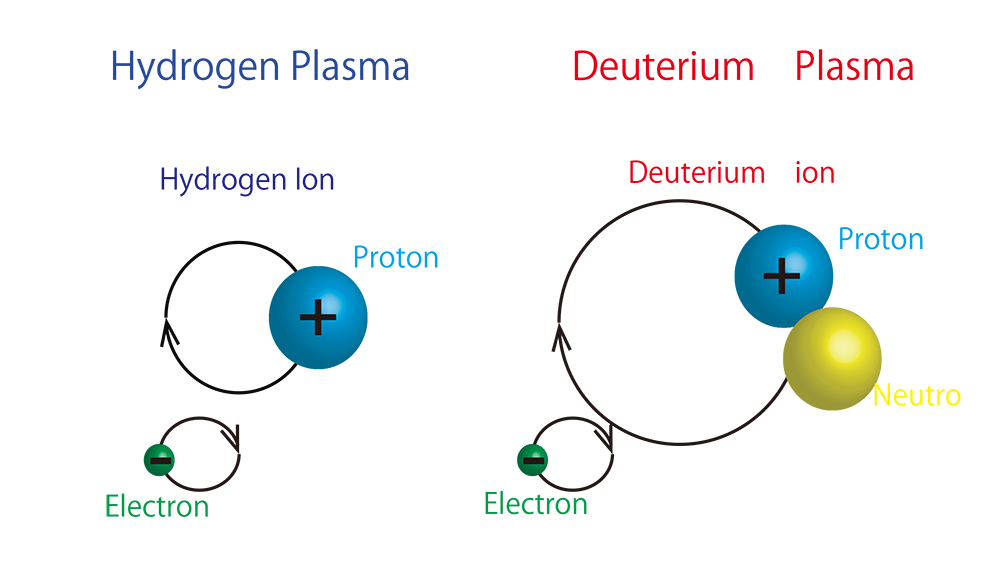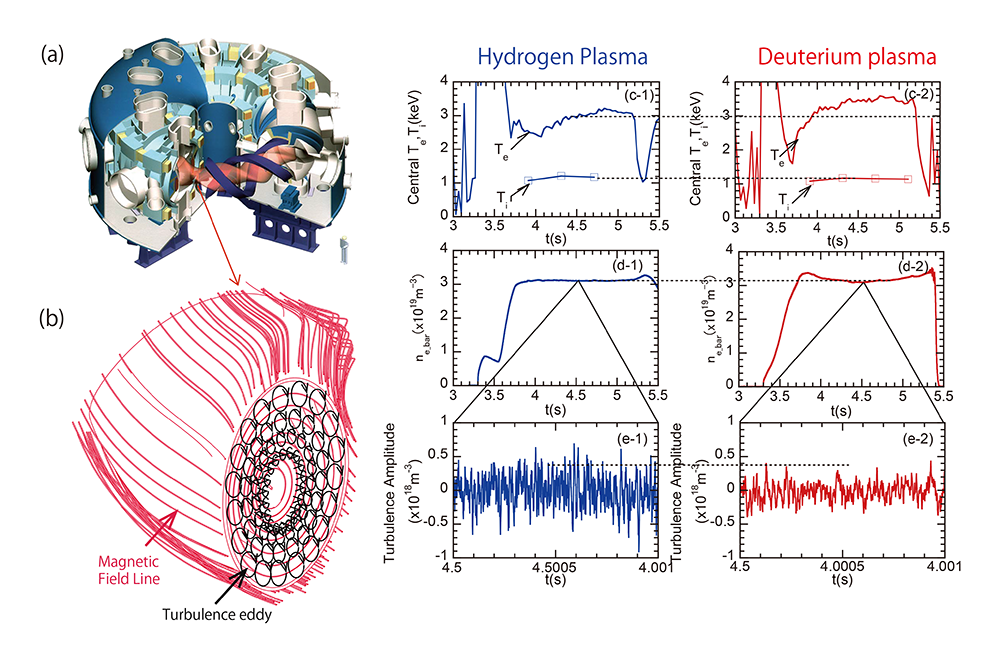Better confinement characteristics in deuterium plasma than in hydrogen plasma
Experiments in the Large Helical Device (LHD) have shown that heavy hydrogen (deuterium) plasma with neutrons in the nucleus has better confinement than light hydrogen (hydrogen) plasma without neutrons in the nucleus, due to reduced plasma turbulence. Future nuclear fusion experiments will use deuterium and tritium with two neutrons in the nucleus, which is even heavier than deuterium. Thus, further improvement of confinement will be expected.


For the prediction of future reactor performance with deuterium and tritium plasma, confinement characteristics are compared in hydrogen and deuterium plasmas. Plasma was heated by electron cyclotron resonant heating, which uses the same principle as a microwave cooking oven. Hydrogen and deuterium plasmas were heated with identical heating power (2 MW) at an identical electron density; however, the plasma produced was completely different. As shown in (c-1), (c-2), the electron temperature was around 10% higher in deuterium plasma than in hydrogen plasma and the ion temperature was comparable. Many theories predict that the turbulence eddy, as shown in (b), causes a degradation of the confinement. Also, the size of the turbulence eddy is in the order of the orbit radius of ions. The orbit radius is larger in deuterium than in hydrogen plasma, and simple theory predicts that the turbulence amplitude is larger in deuterium than in hydrogen plasma.
Then our research group measured the turbulence directly by using a two-dimensional phase contrast imaging technique (2D-PCI) with a CO2 laser. As shown in (d-1), (d-2), the line averaged density was identical. However, the turbulence amplitude was clearly lower in deuterium plasma than in hydrogen plasma, as shown in (e-1) and (e-2). The reduced turbulence amplitude in deuterium plasma possibly causes the higher electro temperature and comparable ion temperature. The confinement improvements are about 10%. However, a 10% improvement in confinement saves the cost of construction of a fusion reactor significantly. Also, better confinement in deuterium plasma than in hydrogen plasma suggests that confinement in mixed deuterium and tritium plasma in future reactors will be further improved, effectively due to the heavier ion mass. This is a favorable prediction.
However, such improvements in deuterium, rather than in hydrogen plasma were not observed in a low density operational regime. We may need to operate at a higher density to realize the confinement improvement with a heavier ion mass. In addition, the physics mechanism in order to explain the observations is not yet clearly understood, although there are several candidates for the physics story. Further investigations are necessary.
This research work was conducted by Prof. Tanaka’s group with domestic and international collaboration from Dr. Yoshiaki Ohtani of the National Institutes for Quantum Science and Technology (QST), Japan, Dr. Felix Warmer of the Max-Planck-Institut für Physik, Greifswald, Germany, Dr. Tuomas Tala of VTT, Finland, Dr. Tsuyoshi Akiyama of General Atomics, United States, Dr. Clive Michael of the University of California, Los Angeles and Prof. Leonid Vyacheslavov of the Budker Institute of Nuclear Physics, Russia.
The research result was published on December 16, 2019 in Plasma Physics and Controlled Fusion, an international journal on plasma physics.
